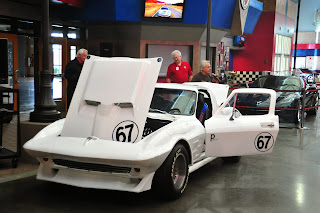He purchased and engine and a six-speed transmission from Chevrolet, and a body and frame from D&D Corvette in 1996. After eight years of carefully putting the car together, it was on the race circuit for five years, at shows for a year and then retired to Dick's barn. "It was built as a show car. In a barn [people] could not appreciate it." Dick felt strongly that people needed to see the car, and there was no chance of that in his barn.
"Talking with Johnny Downs [NCM Board Member], he kind of triggered the idea that it would get an everlasting view from the public if it were at the Museum," said Dick. "And I gave thought to it, and I didn't have to think too hard. And it's my indeed honor to put this in this building and have the public exposed to it."
 Dick’s Corvette has many unique features incorporated,
including front fender louvers that were fabricated and are thought to be the
only pressure relief in the front fenders of any Grand Sport replica. The seats use dune buggy slugs with a support
built up around them.
Dick’s Corvette has many unique features incorporated,
including front fender louvers that were fabricated and are thought to be the
only pressure relief in the front fenders of any Grand Sport replica. The seats use dune buggy slugs with a support
built up around them.Dick says the most unintentional modification on the car is the split rear window. Zora Arkus-Duntov, the creator of the Grand Sports, disliked the ’63 Split Window because it hampered rear vision, so the race version of the car had a vented one piece rear window. Dick’s intention was to do the same, but after a series of unfortunate events Dick created what he calls the “Worf Module” because of its resemblance to the Star Trek character.
The car also incorporates some parts that are not your run-of-the-mill automotive nuts and bolts. “For many years I worked with a company that manufactured a medical tool,” said Dick. “Over those same years all kinds of obsolete or surplus medical materials were donated that were of no use to the company. Rather than see the various screws and devices scrapped I acquired a varied selection of materials. Much of this material is used throughout this car.”
Dick said many of the covers and enclosures are held together with stainless medical lag screws, the inside door handles are chrome cobalt artificial hip joint heads, the trunk door rod is a scoliosis spinal support fixation rod and the plugs in the Cross Ram Weber carburetor velocity stacks are spinal anchor fixtures.
“The Grand Sport project was a real education for me, and probably my last. It seems ironic that the racing life of the original Grand Sports lasted only about five years, and the Chaparral2 World Class racing program only a couple of years longer, yet those two programs are giants in road racing history,” said Dick. And even yet, the technological legacy of the Chaparral racers still lives today in contemporary racing.”

